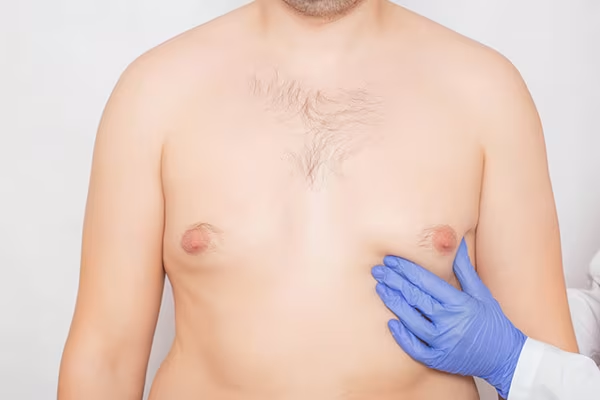Gynecomastia surgery, or male breast reduction, is a procedure aimed at reducing excess breast tissue in men, resulting in a flatter, firmer, and more contoured chest. While the cosmetic surgery itself is significant, the recovery time is equally important to ensure optimal results and patient satisfaction.
Understanding what to expect after the surgery can help prepare patients for the healing process.

What is Male Breast Reduction (Gynecomastia)?
Male Breast Reduction, also known as gynecomastia surgery, is a type of breast surgery specifically designed to address the condition of gynecomastia. This condition is characterized by the overdevelopment of breast tissue in males, leading to enlarged breasts that can cause psychological distress and impair self-confidence.
It’s not uncommon for men and teenage boys suffering from gynecomastia to feel as though they have female breasts, which can be a significant source of discomfort and embarrassment.
Gynecomastia surgery, performed by a skilled plastic surgeon, is a surgical treatment that addresses this issue by removing excess glandular tissue and fat, and in some cases, excess skin, to achieve a more traditionally masculine chest contour. This procedure is often combined with liposuction, for optimal results.
Understanding the Recovery Process
The recovery after gynecomastia surgery begins immediately after the procedure and has several stages. Patients are provided with post-surgery care instructions to minimize discomfort and ensure the healing process progresses smoothly. It is crucial to prepare for recovery according to these guidelines.
Post-Surgery Care Instructions
At the initial consultation, specific instructions will be given to manage the healing process effectively. These include guidance on how to care for the surgical site, medications to take to aid healing and reduce the risk of infection, and when to follow up with the surgeon. A compression garment is often recommended to support the chest area and help reduce swelling.
Managing Pain and Discomfort
Post-operative pain is typically managed with medications. Over-the-counter pain relievers like Tylenol are often sufficient, but prescription pain medication may be provided if necessary. It’s important to follow the prescribed dosages and schedule to maintain comfort during the initial recovery period.
Potential Risks and Complications
As with any surgical procedure, there are potential risks and complications associated with gynecomastia surgery. These can include infection, bleeding, blood clots, and adverse reactions to anesthesia. Choosing a board-certified plastic surgeon, following post-operative instructions, and attending follow-up appointments can help mitigate these risks.
Timeline for Recovery
The recovery timeline is broken down into several phases, each with its milestones and aftercare instructions.
Immediate Post-Surgery Period
Immediately following the procedure, it is normal for patients to experience swelling and some discomfort. Rest is very important during this phase, and activities should be limited to promote healing. Post-op instructions include abstaining from alcohol for at least four weeks after the surgery and avoiding salty foods which adds to swelling and discomfort.
Weeks 1-2: Healing and Swelling Reduction
In the first couple of weeks after gynecomastia surgery, patients typically observe a significant reduction in swelling and bruising. The body is actively healing during this period, and many gynecomastia patients can return to work, provided their job does not involve heavy physical exertion.
Weeks 3-4: Resuming Normal Activities
By 3-4 weeks, patients often feel ready to gradually resume their normal activity level and light exercise, such as walking, which can promote blood flow and healing. It’s important to continue avoiding vigorous exercise, such as weight training or high-impact sports, to prevent any complications or delays in the healing process.
Months 1-3: Final Results Start to Show
The first three months are a critical period as the body adapts to the changes from surgery. During this time, the final results of the gynecomastia surgery will start to become more apparent. As the swelling continues to subside, the new chest contour will reveal itself.
At some point after the 4th week, the patient will be cleared to do strenuous exercise. Patients need to maintain regular follow-up visits with their surgeon to monitor progress and ensure that the recovery is on track.
Tips for a Smooth Recovery
A smooth recovery process is key to achieving the best possible gynecomastia surgery results and reducing the risk of complications. Here are some tips to help along the way.
Take Prescribed Medications
Follow the surgeon’s schedule for prescribed medications, including pain relievers and antibiotics, to manage discomfort and prevent infection during recovery.
Get Enough Sleep
Patients should also ensure they are getting enough sleep, as quality rest enhances the body’s healing ability and gives the body time to recover.
Wear Compression Garments
Use compression garments as directed to support the surgical area, minimize swelling, and shape the chest.
Stay Hydrated
Drink sufficient water daily to facilitate the flushing of toxins, reduce swelling, and promote tissue healing.
Practice Proper Wound Care
Maintain clean and dry incision sites following the surgeon’s wound care instructions, and call Dr. Vitenas immediately if you see signs of infection.
Use Ice Packs or Gel Packs
Relieve swelling and discomfort with a cold compress and ice or gel packs wrapped in cloth. Use them as recommended by the surgeon to balance swelling reduction with blood flow for healing.
Maintain a Healthy Lifestyle
Maintaining a healthy lifestyle is essential for a smooth recovery and optimal surgical results after undergoing gynecomastia surgery. This includes adhering to a balanced diet rich in nutrients that promote wound healing, such as protein, vitamins, and minerals. Consuming a healthy diet not only aids in the recovery process but also helps in maintaining a stable weight, which is crucial as significant weight fluctuation can impact the results of the surgery.
Regular physical activity, once cleared by the surgeon, is also beneficial. Starting with light exercise such as walking can promote blood flow and healing, and over time, patients can gradually reintroduce more strenuous activities like weight training into their routine.
Managing Expectations for Results
Setting realistic expectations for the outcome of gynecomastia surgery is important for patient satisfaction. While the goal is to achieve a flatter, more masculine appearance, the optimal healing process takes time, and the final results will not be immediately visible.
Swelling and Bruising
Swelling and bruising are normal parts of the body’s response to surgery and can take several weeks to resolve. It’s important for patients to understand that these are temporary and not indicative of the final results. Following the surgeon’s instructions for wearing compression garments and managing activities can help minimize these effects.
Scar Appearance and Fading
Scars from gynecomastia surgery are permanent, but they will fade over time. Dr. Vitenas strategically places incision lines for minimal scar visibility. Patients may be advised to use scar creams or gels to aid in the fading process. Adhering to sun protection guidelines is also crucial, as UV exposure can darken scars and make them more noticeable.
Final Contour and Chest Appearance
The final contour and chest appearance following gynecomastia surgery, a type of breast reduction surgery, is a crucial aspect of the recovery process. This process can take several months to fully develop as the body adjusts to the changes and healing progresses. The surgery for gynecomastia involves the removal of excess breast tissue, glandular tissue, and in some cases, excess skin.
This results in a more traditionally masculine appearance, a flat chest free of enlarged breasts, which can significantly boost a patient’s confidence and comfort with their appearance.
To find out if gynecomastia surgery is right for you, please contact us at 281-484-0088 and schedule a consultation. During this consultation, Dr. Vitenas will discuss your goals, evaluate your condition, and help you decide if this procedure is right for you.


